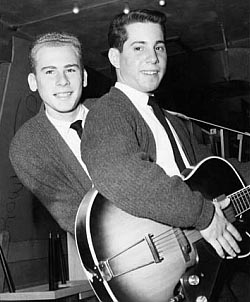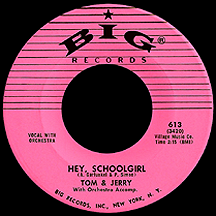TOM AND JERRY
Hey, Schoolgirl
Eleven-year-old Queens, New York elementary school students Arthur (Artie) Garfunkel and Paul Simon first met in 1953, becoming close friends through a mutual interest in music. Inspired by the many New York City doo wop groups of the mid-'50s, they started writing songs together while attending Parsons Junior High School, practicing long hours in Artie's basement. Paul became quite a good guitar player and Artie focused on his vocal aptitude. By the time they entered Forest Hills High, the two had been keeping busy performing all over Queens, in and out of school, whether they were getting paid for it or not.
Living in the largest New York borough had its advantages. It wasn't such an insurmountable distance to the big city should they want to try auditioning for record companies, and though it was difficult getting noticed at first, in 1957 the two 15-year-olds scraped together 25 dollars, went to Sanders Recording Studio and banged out a demo of a song they had written. Fans of The Everly Brothers, who were red hot at the time with "Bye Bye Love" and "Wake Up Little Susie," they performed "Hey, Schoolgirl" in an Everly-inspired, though rough-hewn, style. Breaking in must have seemed easy after that; Sidney Prosen of Big Records (a small label in spite of its name) saw potential in the teen duo (Sid had been established in the music business for a few years, having his most notable success as the composer of Teresa Brewer's number one 1953 hit, "Till I Waltz Again With You").
The names Simon and especially Garfunkel seemed unlikely to go over if the act was to accomplish anything approaching top-of-the-marquee popularity, so Artie opted for Tom Graph (because he liked to draw on graph paper!) and Paul chose Jerry Landis (using his current girlfriend's last name). A somewhat more polished re-recording of "Hey, Schoolgirl" by Tom and Jerry (backed with "Dancin' Wild," another Garfunkel-Simon composition) hit New York's stores and radio airwaves late in the year on Prosen's Big label, going top ten there before breaking nationally, eventually spending a couple of weeks in the top 50 of Billboard's Best Sellers chart in early 1958. A national TV appearance on American Bandstand followed. So simple to achieve, this thing called success!
Paul tried his hand as a solo singer with a record on Big, "True or False," under the name True Taylor, then there were two more by Tom and Jerry on the label, but none of these caught on as the first single had. With their rock and roll dreams on hold, both enrolled in college in 1959 (Artie at Columbia University and Paul at Queens College) while keeping in close contact with Prosen in the hopes of making more records. The success of "Schoolgirl" paid long-term dividends; there were plenty of opportunities to make records, which they had a lot of fun doing over the next six years. After the singles on Big, they released "That's My Story" on Hunt Records in '59 and one single on Ember, "I'm Lonesome." R&B label King Records even reissued "Hey, Schoolgirl." Their cover of Jan and Dean's "Baby Talk" came out on Bell, at that time a company releasing low-cost soundalike 45s of established hits.

Having dropped to the level of budget-single singers in just two years, Artie and Paul tried their luck separately in attempts to make the charts again, recording under so many pseudonyms it was difficult to keep up with them all. Paul worked at it more fervently, retaining his "Jerry" persona with a record on MGM ("Lonesome") in '59, followed by four singles under the same name for Warwick Records over the next year or so. Art released one on Warwick as Artie Garr at about that time and another on the Octavia label, "Private World" (a ballad similar to "Greenfields" that hinted at his future direction). Paul, still using the Landis name, also had a single on Canadian American Records ("I'm Lonely"), then led the group Tico and the Triumphs on "Motorcycle," an uptempo street corner-style tune (first released on Madison and then Amy Records, a Bell subsidiary), which briefly appeared on the charts in January 1962.
There were three more Tico singles, then Tom and Jerry got together again with an ABC-Paramount single (the Everlyesque "Surrender, Please Surrender"), after which Paul was back to being Jerry Landis with "The Lone Teen Ranger" on Amy, a borderline novelty complete with six-gun sound effects; the single slipped onto the low end of the charts in early 1963. Next he released a 45 on the Tribute label as Paul Kane (a name he had used once before during an early-'60s songwriting stint at Manhattan's Brill Building); the guitar-based folk ballad "Carlos Dominguez" was delivered with a maturity previously unheard.
In 1964, with the folk movement on the verge of crossing rock boundaries, the guys were given an opportunity to record for a major label, and using their own names, too! The result was the Simon and Garfunkel album Wednesday Morning, 3AM on Columbia, which initially flopped, further indication that the idea their real names weren't commercially viable was a correct one. They separated again and Paul went overseas to check out the U.K. folk scene. But the split was temporary. Bigger things were coming and there would be no need to use the names Tom and Jerry again.


